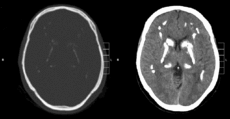- Fahr's syndrome
-
Fahr's syndrome Classification and external resources 
Idiopathic Basal Ganglia CalcificationOMIM 213600 DiseasesDB 32200 Idiopathic Basal Ganglia Calcification, also known as Fahr disease or Fahr’s Syndrome is a rare,[1] genetically dominant, inherited neurological disorder characterized by abnormal deposits of calcium in areas of the brain that control movement, including the basal ganglia and the cerebral cortex. It is a rare degenerative neurological disorder characterized by calcifications and cell loss within the basal ganglia.[2]
A locus at 14q has been suggested, but no gene has been identified.[3] However, basal ganglia calcification can occur as a consequence of other known genetic conditions.
Contents
History and terminology
The disease was first noted by German neurologist Karl Theodor Fahr in 1930.[4][5] A less common name for the condition is Chavany-Brunhes syndrome and Fritsche’s syndrome, the former named after Jacques Brunhes, Jean Alfred Émile Chavany, while the later named after R. Fritsche.[6][7]
Prognosis
There is no cure for Fahr’s Syndrome, nor is there a standard course of treatment. Treatment addresses symptoms on an individual basis. Case reports have suggested that haloperidol or lithium carbonate may help with psychotic symptoms.[8]
The prognosis for any individual with Fahr’s Syndrome is variable and hard to predict. There is no reliable correlation between age, extent of calcium deposits in the brain, and neurological deficit. Since the appearance of calcification is age-dependent, a CT scan could be negative in a gene carrier who is younger than the age of 55.
Progressive neurological deterioration generally results in disability and death.
Source
This article is based on a Q&A website prepared by NINDS [1], part of the National Institutes of Health located in Bethesda, Maryland.
See Also
References
- ^ http://rarediseases.info.nih.gov/GARD/Disease.aspx?PageID=4&diseaseID=8272
- ^ JNNP - Sign In Page
- ^ Geschwind DH, Loginov M, Stern JM (September 1999). "Identification of a locus on chromosome 14q for idiopathic basal ganglia calcification (Fahr disease)". Am. J. Hum. Genet. 65 (3): 764–72. doi:10.1086/302558. PMC 1377984. PMID 10441584. http://linkinghub.elsevier.com/retrieve/pii/S0002-9297(07)62329-5.
- ^ T. Fahr: Idiopathische Verkalkung der Hirngefässe. Zentralblatt für allgemeine Pathologie und pathologische Anatomie, 1930-1931, 50: 129-133.
- ^ http://www.whonamedit.com/synd.cfm/451.html
- ^ http://www.whonamedit.com/synd.cfm/1518.html
- ^ http://rarediseases.info.nih.gov/GARD/QnA.aspx?PageID=4&CaseID=22373&DiseaseID=8272
- ^ Munir KM. The treatment of psychotic symptoms in Fahr's disease with lithium carbonate. J Clin Psychopharmacol. 1986 Feb;6(1):36-8.
External links
Categories:- Neurological disorders
- Genetic disorders with OMIM but no gene
- Rare diseases
Wikimedia Foundation. 2010.
